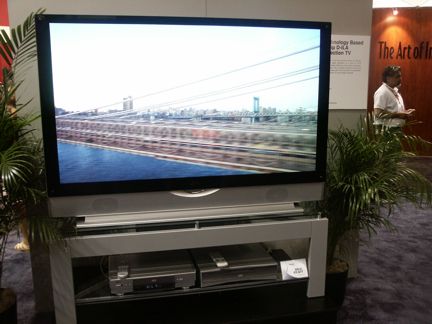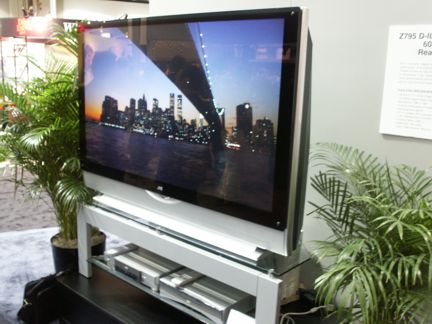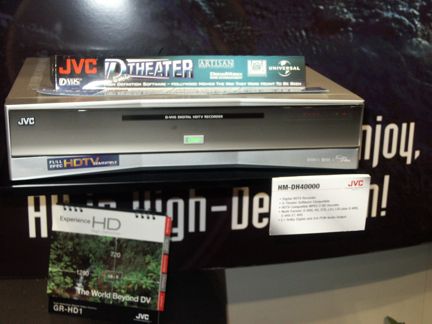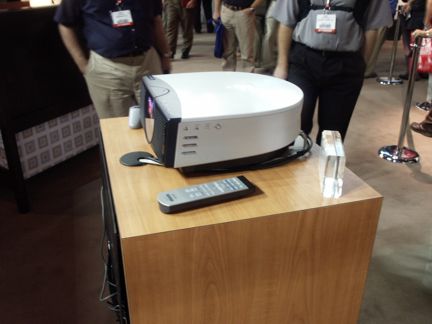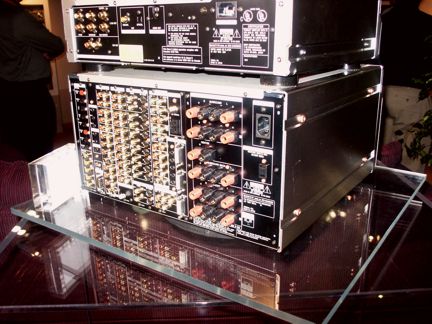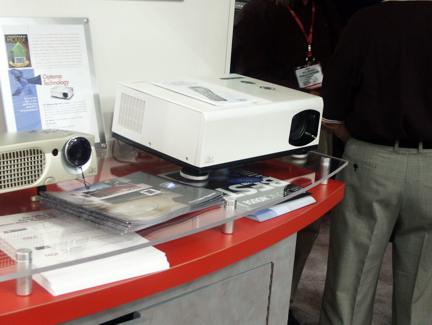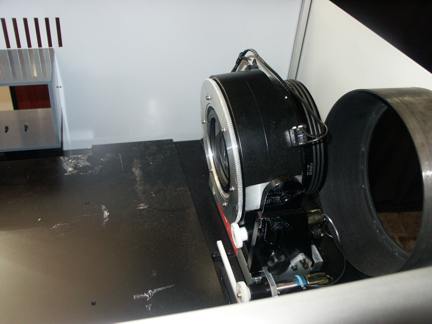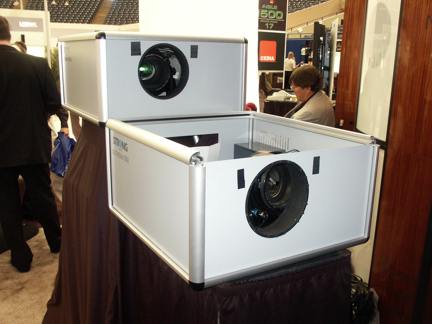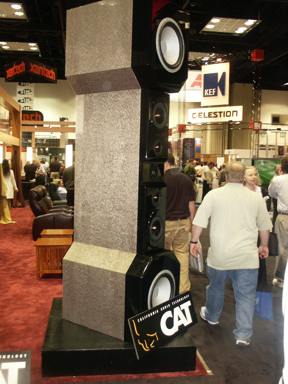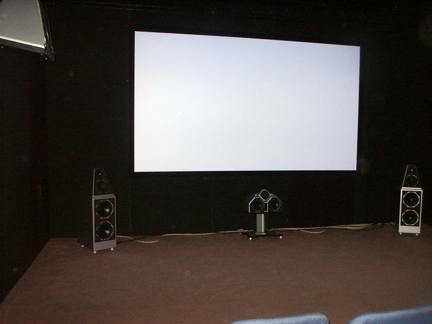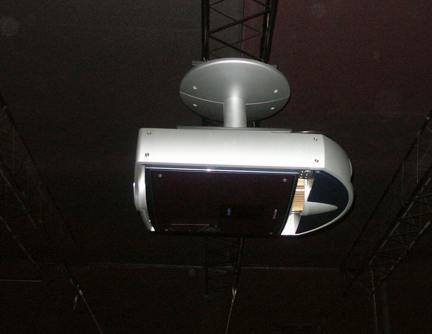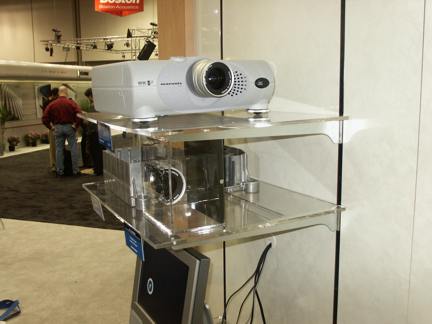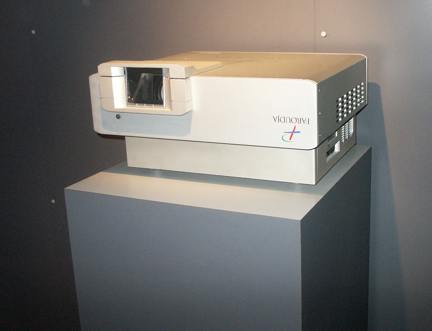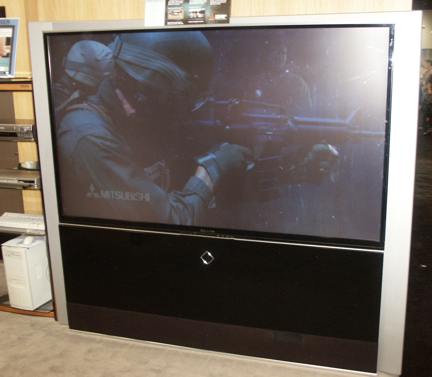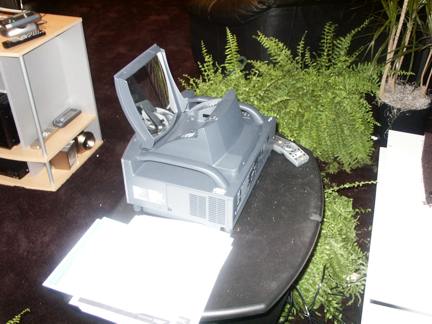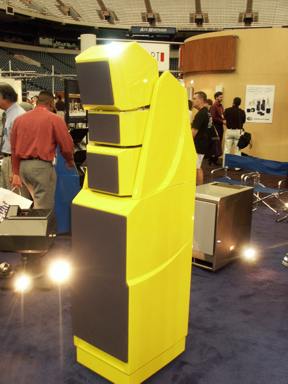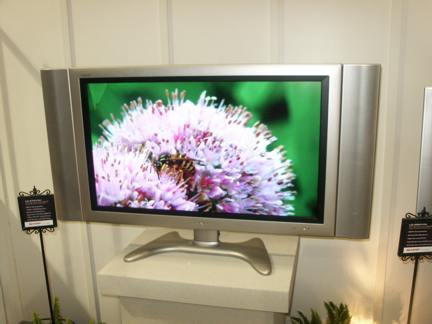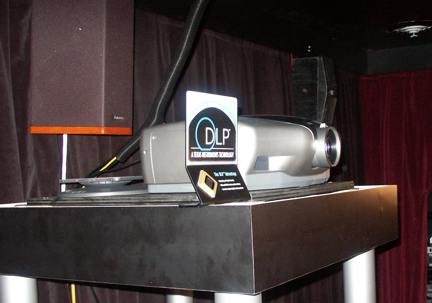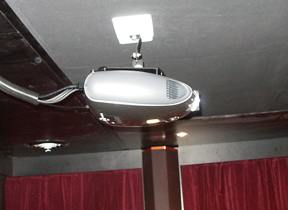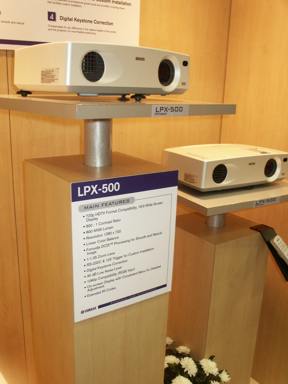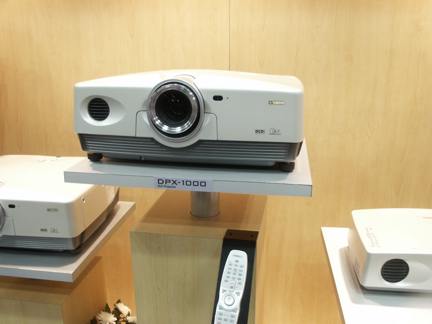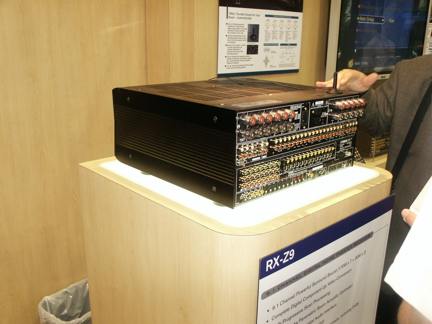Spent two+ days in Indianapolis checking out the CEDIA Expo 2003. I love projectors so there are more pictures and notes about that subject than some of the others. Posted 9/22/2003.
Contents:
Projectors:
In last years report (2002) I divided my projector notes between digital and CRT projectors, while there were still more digitals than CRT's, there were still at least 10 CRT projectors in attendance in 2002. In 2003 there were only two that I found. No real news here, digitals keep getting better, are more economical to produce, easier to set up, and provide bright, sharp images.
Asked to describe my overall impressions of this years projector crop, I'd call it evolutionary. Nothing radically new, just a lot of refinement and a real sense that projector manufacturers are really catching on to what the home theater market wants. Regarding picture quality, in general the latest DLP's had better contrast and lower digital (dithering) noise than last year. There were many more projectors that I felt I could live with or recommend than ever before.
A show floor like CEDIA Expo is not exactly an ideal place to subjectively evaluate projectors. There is little opportunity to A-B compare and set up quality and conditions vary widely. I'll stick with general impressions and note where the environment may have had an undo effect on the projector's performance. This report is compiled from my notes, photos, manufacturer's literature and manufacturer's websites; many of these products are pending final release.
Runco: Showed the HD2 single chip DLP model VX-5000ci and the three chip VX-5c. Both on Da-Lite HCCV screens, the 3 chipper on a 96" screen and the single chip on what appeared to be an 87". Both had good contrast and black levels. Runco showed some HD footage on the VX-5000ci of Sam Runco with an all black outfit on; you could see the folds of the material and the ribbing on the fabric. Well set up theater to show off the projectors. Interesting design by Cinema Design Group featured dye sublimate printed acoustic panels featuring underwater scenes.
Sony: Sony had lots of new stuff to see. First they have updated the popular Cineza line of LCD projectors with two new models. The VPL-HS3 (WSVGA) replaces the HS2, and the VPL-HS20 (WXGA) replaces the HS10. Both have similar appearances to their predecessors. Contrast and the on board scaler seem to have been improved. If you've liked the previous Cineza's you'll like the new crop, more features same or lower price point. Sony was showing these projectors in a darkened booth on a 106" Da-Lite screen with DVD material.
The real news at the Sony booth was the Qualia 004, Sony's first LCoS projector. JVC calls their LCoS chips D-ILA, Sony calls theirs SXRD. The Qualia is a full HD resolution projector at 1920 x 1080 pixels. Sony showed it projecting 1080p high definition material onto a 160" Stewart StudioTek 130 screen. The projector had no troubles producing a bright incredibly detailed image on this very large screen. I've always liked the smooth picture LCoS technology produces and the SXRD delivered. No screendoor visible at all. Contrast was good, subjectively it appeared to me to be in the 800:1 range. Hand built in Japan for an estimated MSRP of $25,000 USD without a lens. Both long and short throw lenses will be available. See the pictures. The audio featured Sony's new flagship receiver and Wilson Audio speakers.
Marantz: Cinema VPL-12S3: HD2+ DLP, demo material "Victorias Secret" in HD and NHL hockey in HD. Used an 87" wide Vutec Silverstar high gain screen (~3.0 gain), which really worked quite well with the projector. I would rank the 12S3 number 1 for absolute black level among digital projectors at the show, downright inky. Among the innovations found on the new Marantz HD2+ is a proprietary yellow filter on the lamp, adjustable aperature, and an additional dark green segment on the color wheel to improve contrast and shadow detail. The 12S3 will ship with a small sensor that fits on the lens that will allow the projector to set a correct greyscale automatically. Has short and long throw lens options. Retail MSRP $12,999USD. Marantz also showed an prototype 3-chip 720p machine, considerably brighter than the 12S3, really to bright for the high gain Vutec, this machine also displayed very good black levels.
Screenplay: Screenplay's big push this year was two fold. First, they have developed an entire family of projectors to cover the home theater range from entry level to high performance home cinema. Second, Screenplay is moving to a more closely controlled distribution network for its home theater projectors, primarily custom installers. Screenplay showed, from entry level up, the Screenplay 4800 (similar to the Infocus X1, SVGA, 1000 lumens, DCDi), the 5700 (Matterhorn DMD at 1024 x 576 resolution, 1000 lumens, DCDi) which debuted this spring and holds the lower middle ground, the 7200 and 7205 (7205 is the eventual replacement for the 7200 when it ships late 2003, HD2+ DMD, 720p, DCDi), and a prototype 3-chip 720p projector for really big screens. All looked sharp and bright. The 7205 and 5700 were shown on 96" Da-Lite HCCV screens, while the three chipper was on a 12' wide screen.
Sharp: Upgrades the XV-Z10000 DLP projector shown last year to the XV-Z12000. The Z12000 uses the HD2+ DMD from TI, with a 7 segment color wheel with a dark green segment for inproved contrast, 1000 lumens but lower in high contrast mode. Looked sharp (pun intended) but did not have the absoulte black levels and shadow details of some of the competition. Shown on a 96" Draper M2500 screen. Also introduced is the XV-Z200, a 1024 x 576 DLP projector with 800 lumens and 2000:1 contrast. The XV-Z12000 MSRP is $10995, and the XV-Z200 is $3995.
Optoma: Showed several projectors, the only one I got to see was the H76 (see pics below), and unfortunately didn't get to spend much time with it, so I think it best not to pass judgement.
NEC: Showed two projectors, the HT1000, shown with an anamorphic lens that didn't seem to be performing as planned, the next day the lens was gone. The HT1000 is a proven performed with 1024 x 78 resolution, high contrast of 3000:1 and NEC's Sweetvision processing. NEC's new offering is the WT-600 DLP projector. The WT-600 projector uses no lenses, the image is shaped by a series of aspherical mirrors. To get a usable picture this projector can be mounted just two feet from the screen (60" diagonal from a 16 cm mounting distance). Could be great for those with limited space but big screen tastets. Uses the LT (LT240K) engine. An upgrade to a newer chipset and addtion of a proper scaler would make this a proper HT projector, as is it is novel but doesn't keep up with other current HT projectors.
Yamaha: DPX-1000 HD2 DLP projector was back this year, where I got a much better look at it. It is a very capable HD2 machine. Doesn't have as much contrast as the HD2+ machines. Wouldn't be suprised to see Yamaha announce an HD2+ version around CES time. Yamaha was also exhibiting but not demonstrating the LPX-500 LCD projector. Not many LCD's around at CEDIA: Sony, Studio Experience, Yamaha, and Philip
JVC: HX-1 D-ILA projector with UHP lamp, a widescreen version of the SX21. The SX21 is still around and was shown with an ISCO vertical squeeze anamorphic lens. Showing a variety of HD material from JVC D-VHS machines (of course). Very impressive picture, smooth bright. Contrast is inferior to the HD2 and HD2+ DLP machines, but the image was more film like to my taste. JVC was also demonstrating a full HD 1920x1080p DILA projector aimed at the HT market. Not an official product yet but it looked very good.
Samsung: Samsung was one of the first to marked with DLP based RPTV's but up until now they have not offered a front projector. Samsung seems to be doing things right by collborating with Joe Kane on the development of the projector. The projector is an HD2 DLP, it was shown on an 87" wide StudioTek 130 screen. The innovative feature of this projector is that the projector "knows" what is required to properly track a 2.2 gamma, D6500K greyscale. The projector just needs to know where it is at, so you measure the chromaticity coordinates of the projector's output, punch it into one of the menus and voila! the projector recalibrates it's whole output range for NTSC, PAL and ATSC color spaces. Shown exclusively with HD from an Windows Media 9 server, the projector had an excellent picture.
Digital Projection Inc: 3-Chip DLP shown at the TI DLP booth and I understand also shown at a hotel nearby. The model shown was the Mercury HD, 720p resoultion, 1750 lumens, 2400:1 contrast. The display at the TI booth was showing boat and off road driving footage on a 106" wide Da-Lite screen. Unfortunately it was not set up well and the colors were very over saturated and unnatrual looking. Plenty bright for this size or larger screen.
Immersive Inc.: Showed the Virtuoso HD2 DLP projector with DCDi processing. The Assimilator and Hydra video processors were also there but not in operation. Shown on a 90" Stewart screen. This unit ships with contrast and grey scale tracking optimized and it shows. Projector was well set up with smooth darks and minimal artifacts.
Rear Projection and Flat Screen TV's:
The march is on from CRT RPTV to digital. While only a handful of digital rear projection sets were in evidence last year, almost every major manufacturer had one or more sets this year. LCD, DLP and LCoS technologies were all represented.
Plasma gets better and better with better processing and fewer artifacts like contouring.
JVC showed a soon to be released 1366x768 60" DILA based RPTV that was very sharp.
Mitsubishi showed their prototype Diamond WL-82913, a full HD (1920 x 1080p) LCoS based rear projection set at a whopping 82". Not complete and ready to ship yet, but looks very promising (see pics).
The best looking plasma pictures I recall were at the Faroudja booth. Faroudja sells OEM's their plamas and bundles them with one of their scalers.
LCD's keep getting bigger with the biggest now competing with Plasma at the 37"-43" range. In general they are lower contrast but higher resolution displays. Sharp in particular was spotlighting their larger LCD displays.
Audio Gear:
If it is hard to evaluate projectors at an open floor show, then its nearly impossible to properly evaluate audio equipment. I think this is why many high end brands don't even have demos on the floor, just the merchandise.
Meridian: Faroudja had a full Meridian digital system at their booth. Nothing really new here, I just like the Meridian sound. Lovely, great transients and smooth character.
Genelec: Powered speakers from Europe (Finland) that have crossed from the pro monitor market to the home theater market. These relatively small speakers really play loud and strong!
One of the stronger LFE (bass) demo's at the show, with a sub that has 4-12" woofers each with a 400 Watt amp.
Wraith Speakers: I've seen and heard of these speakers before, but never actually heard the speakers. I've heard them now, and they play very cleanly with a good deal of spaciousness.
Wilson Audio had the new X-2 speaker system on display, but the real scoop was providing the speakers for the hottest ticket on the show floor, the Sony SXRD projector demo.
Conclusions:
There is more at this show than you can possibly take in in two days, all you can hope for is to concentrate on a few areas and hit the highlights from the rest.
Controls are also improving. Home Theater master introduced a new color touch screen remote that features a base station with addressible IR emitters for $1000. Can interface with exisiting IR distribution and control systems. AMX and Crestron were of course at the show where they continue to dominate the high end and full integration markets. A new player is Xplore, which produces a line of IP based control products.
A new company, Kalaidescape, had on display a super DVD server system. The system consists of a central server where all DVD's are ripped and stored on hard drives. Each viewing location has a small "pizza box" shaped server that drives the local user interface and streams the DVD over the network.
Media servers are maturing, with better integration with more systems, larger capacties and improved interfaces. Dedicated servers are being challenged by "media interfaces" that mount with your audio/video gear but have a network connection and can stream content from any server on the network to your A/V components.
The keynote address this year was by Mark Cuban of HDNet fame which was fitting because there was a true shift in both the quantity of High Definition material being shown and the novelty of it. It just isn't novel any more, it is expected. This is a good thing because as HD becomes common, accepted, and second nature to professional installers, the more homes will have HD capabilities. This HD expansion can only lead to more and better HD content.
